Generic Cutting Force Modeling with Comprehensively Considering Tool Edge Radius, Tool Flank Wear and Tool Runout in Micro-End Milling
Abstract
1. Introduction
2. Generic Cutting Force Modeling in the Micro-End Milling Process
2.1. Generic Cutting Force Model in Micro-End Milling
2.2. Actual Tool Radius Modeling Considering Tool Edge Radius and Tool Flank Wear
2.3. IUCT Modeling Considering Tool Edge Radius, Tool Flank Wear, and Tool Runout
2.4. Cutting Force Coefficient Determination Considering Tool Flank Wear
3. Experimental Verification and Discussion
3.1. Experimental Setup
3.2. Verification and Analysis of Cutting Force Model
3.2.1. Tool Runout Calibration
3.2.2. The Method of Cutting Force Prediction
3.2.3. Statistical Analysis
3.3. Discussion
3.3.1. Effect of Tool Wear on the Cutting Force
3.3.2. Effect of Tool Wear on the Cutting Force Coefficient
4. Conclusions
- (1)
- The developed model can dynamically consider the impact of tool runout and tool wear, and can reflect in real-time the cutting state and wear of tools in the cutting process. It is helpful to deepen the research on the micro-milling mechanism and optimize the cutting process.
- (2)
- Through a series of micro slot end milling experiments, we have found that the proposed model is more accurate than without considering tool wear. It is necessary to consider the tool wear in the cutting force model based on tool runout. It is due to the gradual increase of the cutting force with the tool wear.
- (3)
- Results show that tool wear significantly affects the forces in the three directions, and the influence on the axial force is the largest. This is caused by the axial wear of the tool end face.
- (4)
- The results show that the influence of tool wear on the cutting force coefficients in the three directions is very significant, and the axial force coefficient increases by 495.39%. It is significant to establish an accurate cutting force coefficient model considering tool wear. This is due to the increase of axial force caused by tool wear.
- (5)
- The established model can be generalized to nano-diamond machining. The research will be extended to different types of tools to establish a more general force model in micro-milling.
Author Contributions
Funding
Conflicts of Interest
References
- Anand, R.S.; Patra, K. Modeling and simulation of mechanical micro-machining-A review. Mach. Sci. Technol. 2014, 18, 323–347. [Google Scholar] [CrossRef]
- Davim, J.P. Modern Mechanical Engineering: Research, Development and Education; Springer Science & Business Media: London, UK, 2014. [Google Scholar]
- Balázs, B.Z.; Geier, N.; Takács, M.; Davim, J.P. A review on micro-milling: Recent advances and future trends. Int. J. Adv. Manuf. Technol. 2021, 112, 655–684. [Google Scholar]
- Chen, N.; Li, H.N.; Wu, J.; Li, Z.; Li, L.; Liu, G.; He, N. Advances in micro milling: From tool fabrication to process outcomes. Int. J. Mach. Tools Manuf. 2020, 160, 103670. [Google Scholar] [CrossRef]
- Aramcharoen, A.; Mativenga, P.T. Size effect and tool geometry in micromilling of tool steel. Precis. Eng. 2009, 33, 402–407. [Google Scholar]
- Vogler, M.P.; DeVor, R.E.; Kapoor, S.G. On the modeling and analysis of machining performance in Micro-End milling, Part Ⅱ: Cutting Force Prediction. J. Manuf. Sci. Eng. 2005, 126, 695–705. [Google Scholar] [CrossRef]
- Bao, W.Y.; Tansel, I.N. Modeling micro-end milling operations. Part II: Tool runout. Int. J. Mach. Tools Manuf. 2000, 40, 2175–2192. [Google Scholar] [CrossRef]
- Altintas, Y. Manufacturing Automation: Metal Cutting Mechanics, Machine Tool Vibrations, and CNC Design; Cambridge University Press: Cambridge, UK, 2000. [Google Scholar]
- Bao, W.Y.; Tansel, I.N. Modeling micro-end milling operations. Part I: Analytic cutting force model. Int. J. Mach. Tools Manuf. 2000, 40, 2155–2173. [Google Scholar]
- Li, H.Z.; Liu, K.; Li, X.P. A new method for determining the undeformed chip thickness in milling. J. Mater. Process. Tech. 2001, 113, 378–384. [Google Scholar] [CrossRef]
- Li, K.; Zhu, K.; Mei, T. A generic instantaneous undeformed chip thickness model for the cutting force modeling in micromilling. Int. J. Mach. Tool Manuf. 2016, 105, 23–31. [Google Scholar] [CrossRef]
- Rodríguez, P.; Labarga, J.E. A new model for the prediction of cutting forces in micro-end milling operations. J. Mater. Process. Tech. 2013, 213, 261–268. [Google Scholar] [CrossRef]
- Li, C.; Lai, X.; Li, H.; Ni, J. Modeling of three-dimensional cutting forces in micro-end milling. J. Micromech. Microeng. 2007, 17, 671–678. [Google Scholar]
- Wojciechowski, S.; Matuszak, M.; Powałka, B.; Madajewski, M.; Maruda, R.W.; Krolczyk, G.M. Prediction of cutting forces during micro end milling considering chip thickness accumulation. Int. J. Mach. Tools Manuf. 2019, 147, 103466. [Google Scholar] [CrossRef]
- Zhang, X.; Ehmann, K.F.; Yu, T.; Wang, W. Cutting forces in micro-end milling processes. Int. J. Mach. Tools Manuf. 2016, 107, 21–40. [Google Scholar] [CrossRef]
- Zhang, Y.; Li, S.; Zhu, K. Generic instantaneous force modeling and comprehensive real engagement identification in micro-milling. Int. J. Mech. Sci. 2020, 176, 105504. [Google Scholar] [CrossRef]
- Zhou, Y.D.; Tian, Y.L.; Jing, X.B.; Ehmann, K.F. A novel instantaneous uncut chip thickness model for mechanistic cutting force model in micro-end milling. Int. J. Adv. Manuf. Technol. 2017, 93, 2305–2319. [Google Scholar] [CrossRef]
- Yuan, Y.J.; Jing, X.B.; Ehmann, K.F.; Cao, J.; Li, H.Z.; Zhang, D.W. Modeling of cutting forces in micro end-milling. J. Manuf. Process. 2018, 31, 844–858. [Google Scholar] [CrossRef]
- Jing, X.B.; Lv, R.; Chen, Y.; Tian, Y.; Li, H. Modelling and experimental analysis of the effects of runout, minimum chip thickness and elastic recovery on the cutting force in micro-end milling. Int. J. Mech. Sci. 2020, 176, 105540. [Google Scholar] [CrossRef]
- Wan, M.; Wen, D.Y.; Ma, Y.C.; Zhang, W.H. On material separation and cutting force pre- diction in micro milling through involving the effect of dead metal zone. Int. J. Mach. Tools Manuf. 2019, 146, 103452. [Google Scholar]
- Sahoo, P.; Pratap, T.; Patra, K. A hybrid modelling approach towards prediction of cutting forces in micro end milling of Ti-6Al-4V titanium alloy. Int. J. Manuf. Sci. 2019, 150, 495–509. [Google Scholar] [CrossRef]
- Shao, H.; Wang, H.L.; Zhao, X.M. A cutting power model for tool wear monitoring in milling. Int. J. Mach. Tools Manuf. 2004, 44, 1503–1509. [Google Scholar]
- Sun, Y.J.; Sun, J.; Li, J.F.; Li, W.D.; Feng, B. Modeling of cutting force under the tool flank wear effect in end milling Ti6Al4V with solid carbide tool. Int. J. Adv. Manuf. Technol. 2013, 69, 2545–2553. [Google Scholar] [CrossRef]
- Chinchanikar, S.; Choudhury, S.K. Predictive modeling for flank wear progression of coated carbide tool in turning hardened steel under practical machining conditions. Int. J. Adv. Manuf. Technol. 2015, 76, 1185–1201. [Google Scholar] [CrossRef]
- Chinchanikar, S.; Choudhury, S.K. Cutting forces modeling considering tool wear effect during turning of hardened AISI4340 alloy steel using multi-layer TiCN/Al2O3/TiN-coated carbide tools. Int. J. Adv. Manuf. Technol. 2016, 83, 1749–1762. [Google Scholar] [CrossRef]
- Hou, Y.F.; Zhang, D.H.; Wu, B.H.; Luo, M. Milling force modeling of worn tool and tool flank wear recognition in end milling. IEEE ASME Trans. Mechatron. 2015, 20, 1024–1035. [Google Scholar] [CrossRef]
- Orra, K.; Choudhury, S.K. Mechanistic modelling for predicting cutting forces in machining considering effect of tool nose radius on chip formation and tool wear land. Int. J. Mech. Sci. 2018, 142, 255–268. [Google Scholar] [CrossRef]
- Nouri, M.; Fussell, B.K.; Ziniti, B.L.; Linder, E. Real-time tool wear monitoring in milling using a cutting condition independent method. Int. J. Mach. Tools Manuf. 2015, 89, 1–13. [Google Scholar] [CrossRef]
- Shi, K.N.; Zhang, D.H.; Liu, N.; Wang, S.B.; Ren, J.X.; Wang, S.L. A Novel Energy Consumption Model for Milling Process Considering Tool Wear Progression. J. Clean. Prod. 2018, 184, 152–159. [Google Scholar] [CrossRef]
- Bao, W.Y.; Tansel, I.N. Modeling micro-end milling operations. Part III: Influence of tool wear. Int. J. Mach. Tools Manuf. 2000, 40, 2193–2211. [Google Scholar] [CrossRef]
- Oliaei, S.N.B.; Karpat, Y. Influence of tool wear on machining forces and tool deflections during micro milling. Int. J. Adv. Manuf. Technol. 2016, 84, 1963–1980. [Google Scholar] [CrossRef]
- Lu, X.; Wang, F.; Jia, Z.; Si, L.; Zhang, C.; Liang, S.Y. A modified analytic cutting force prediction model under the tool flank wear effect in micro-milling nickel-based super alloy. Int. J. Adv. Manuf. Technol. 2017, 91, 3709–3716. [Google Scholar] [CrossRef]
- Zhang, X.; Yu, T.; Dai, Y.; Qu, S.; Zhao, J. Energy consumption considering tool wear and optimization of cutting parameters in micro milling process. Int. J. Mech. Sci. 2020, 178, 105628. [Google Scholar] [CrossRef]
- Li, G.; Li, S.; Zhu, K. Micro-milling force modeling with tool wear and runout effect by spatial analytic geometry. Int. J. Adv. Manuf. Technol. 2020, 107, 631–643. [Google Scholar] [CrossRef]
- Liu, T.; Zhu, K.; Wang, G. Micro-milling tool wear monitoring under variable cutting parameters and runout using fast cutting force coefficient identification method. Int. J. Adv. Manuf. Technol. 2020, 111, 3175–3188. [Google Scholar] [CrossRef]
- Zhu, K.P.; Li, G. Theoretical Modeling and Experimental Study of Micro Milling Force Based on Tool Wear Mapping. J. Mech. Eng. 2021, 19, 246–259. [Google Scholar]
- Liu, T.; Liu, Y.; Zhang, K. An improved cutting force model in micro-milling considering the comprehensive effect of tool runout, size effect and tool wear. Int. J. Adv. Manuf. Technol. 2022, 120, 659–668. [Google Scholar] [CrossRef]

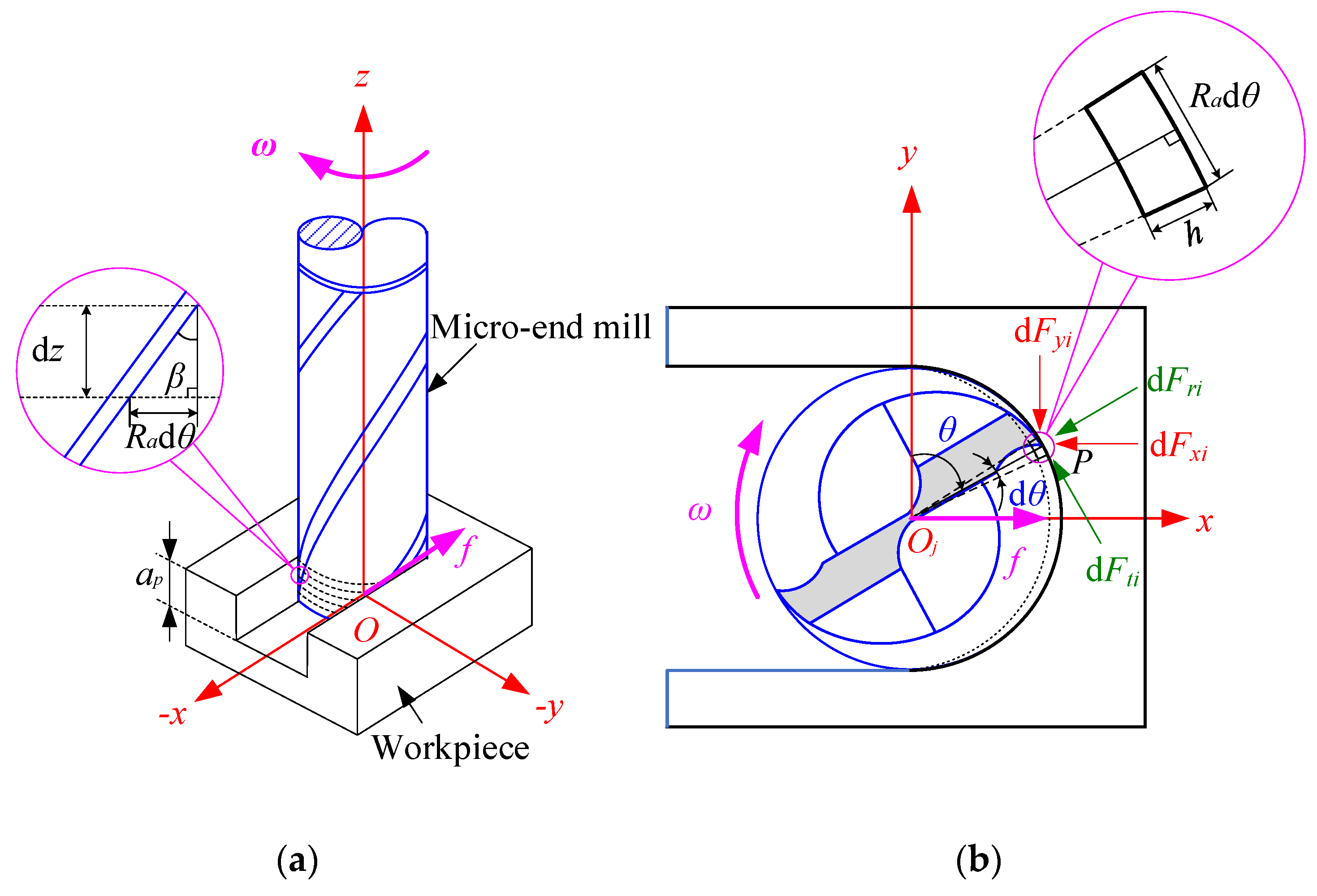

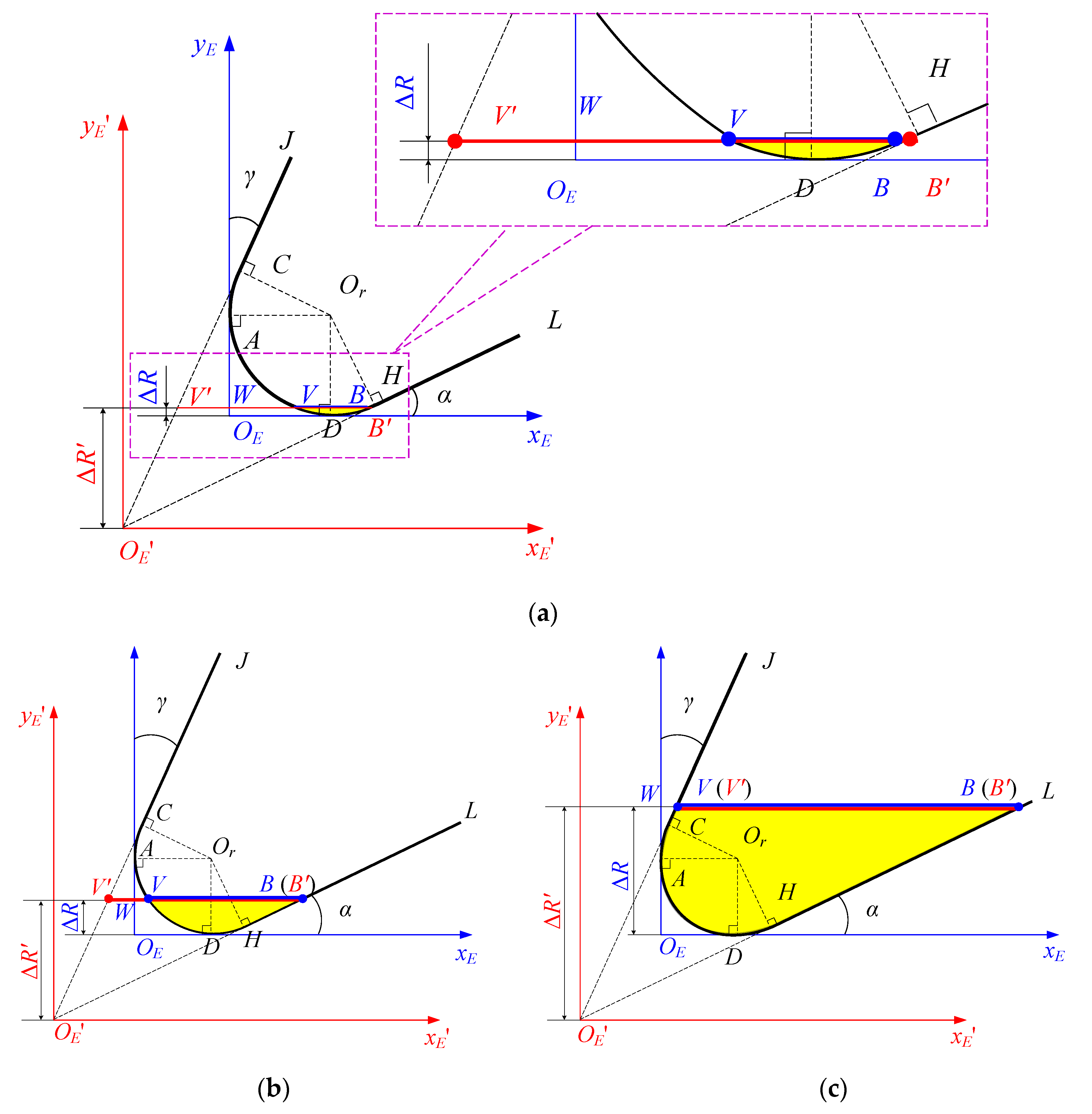
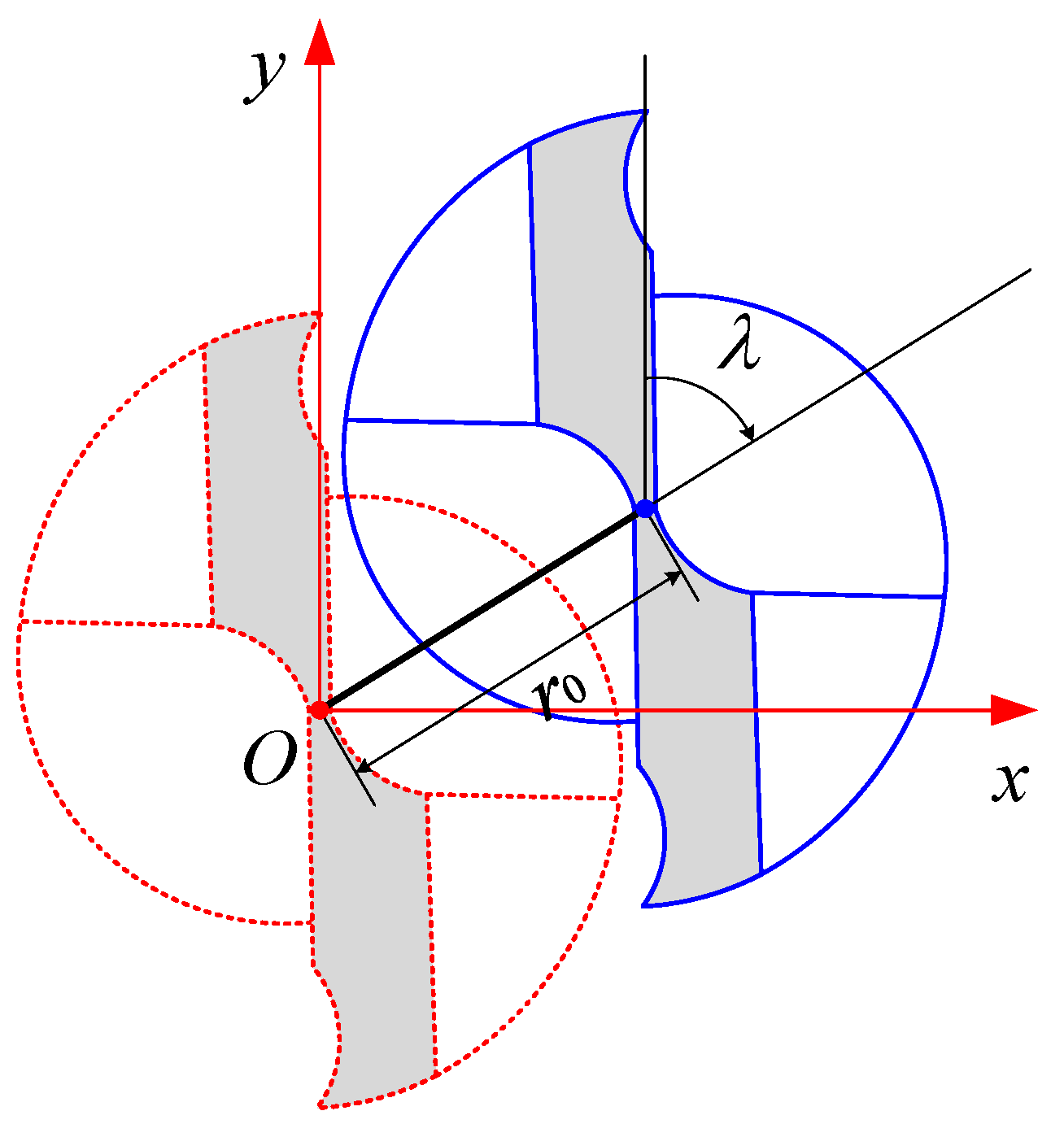
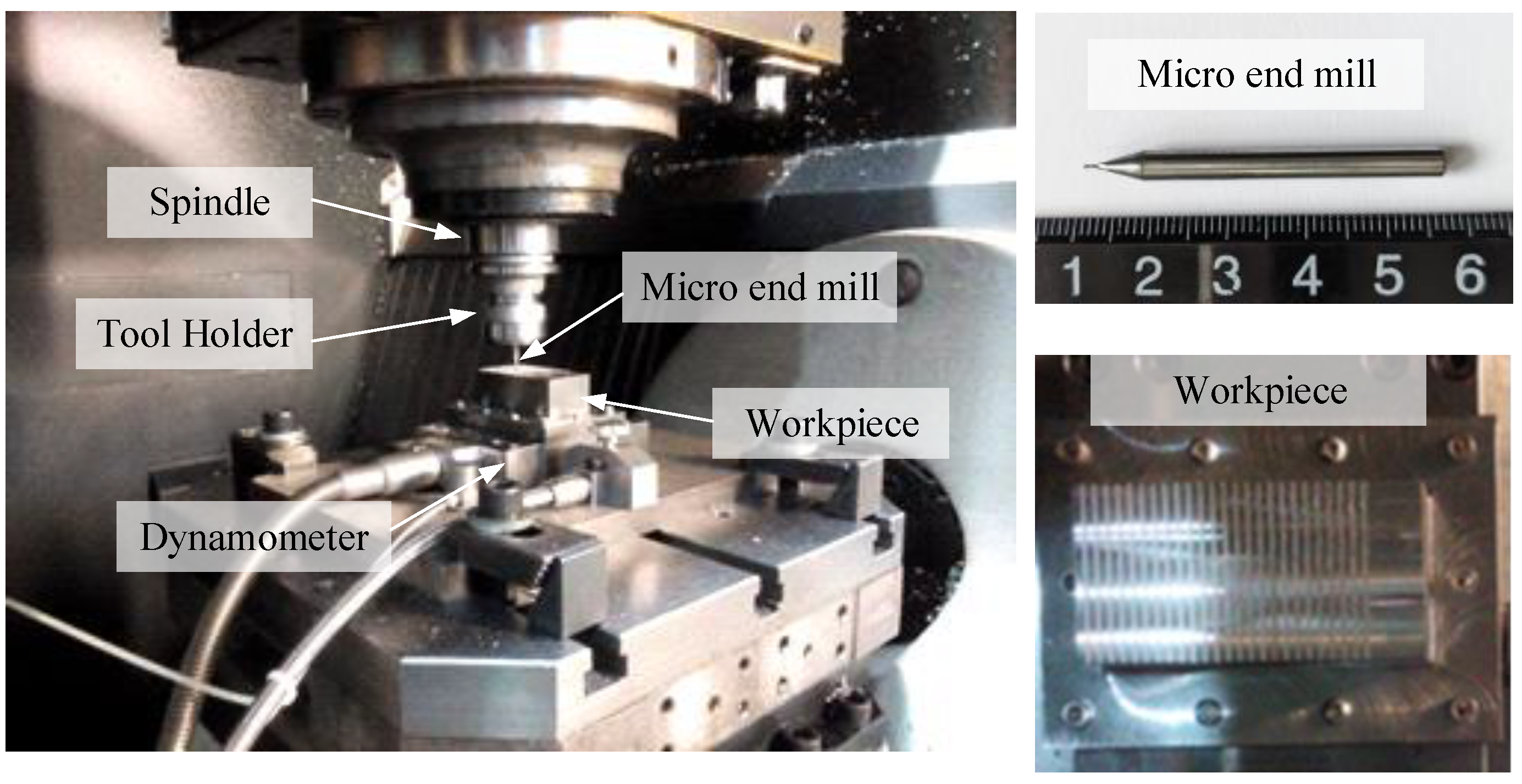
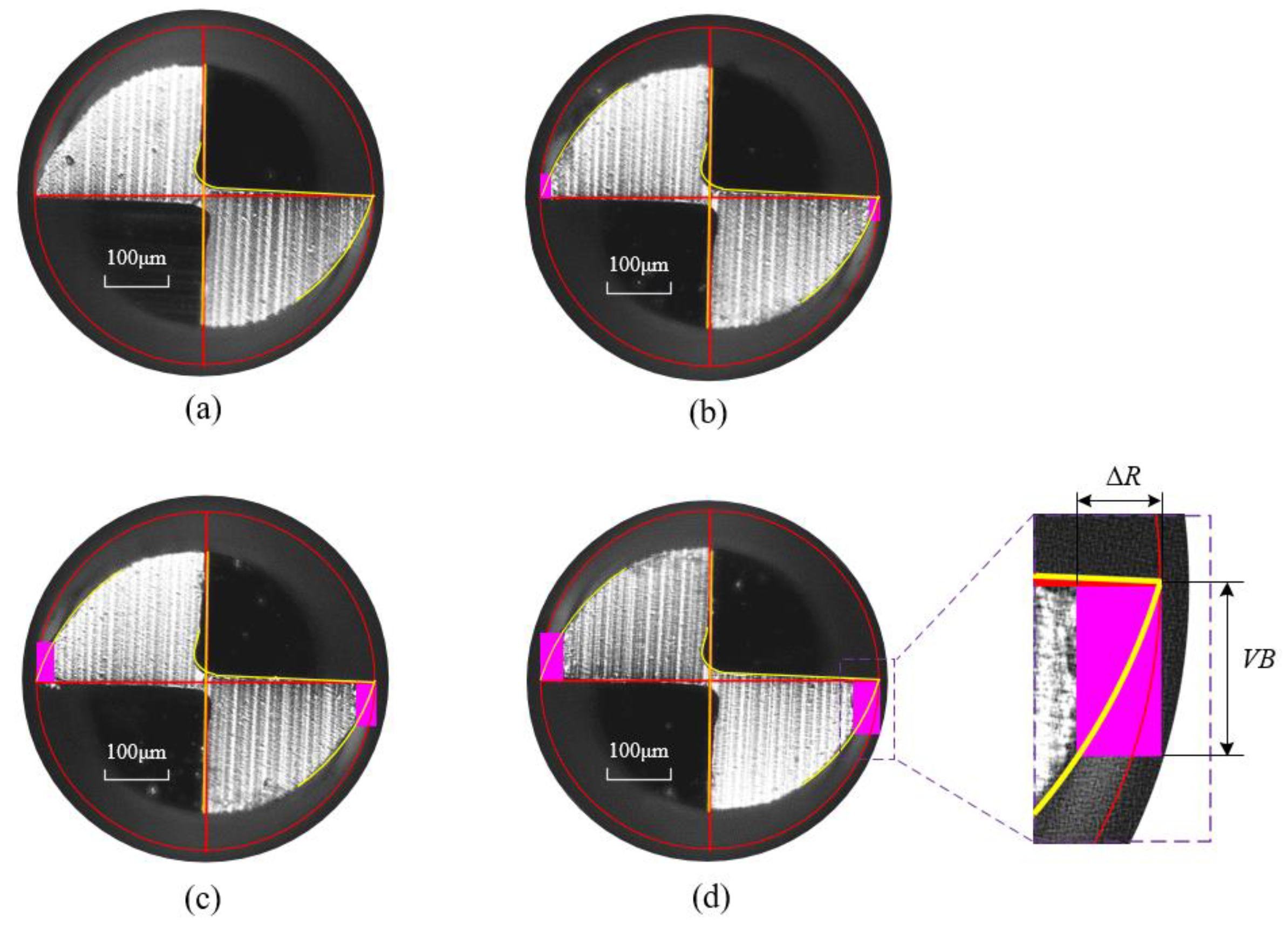
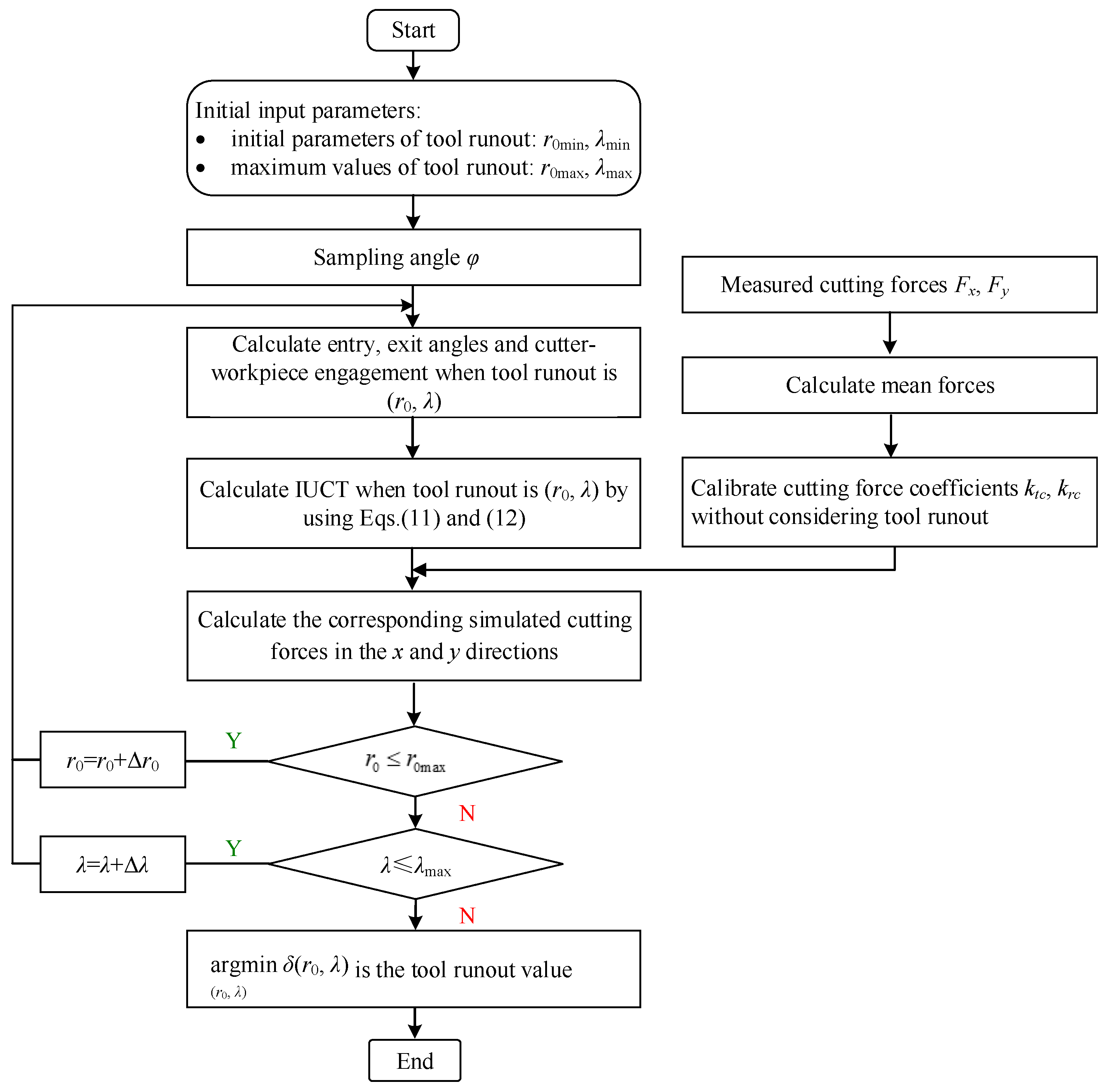
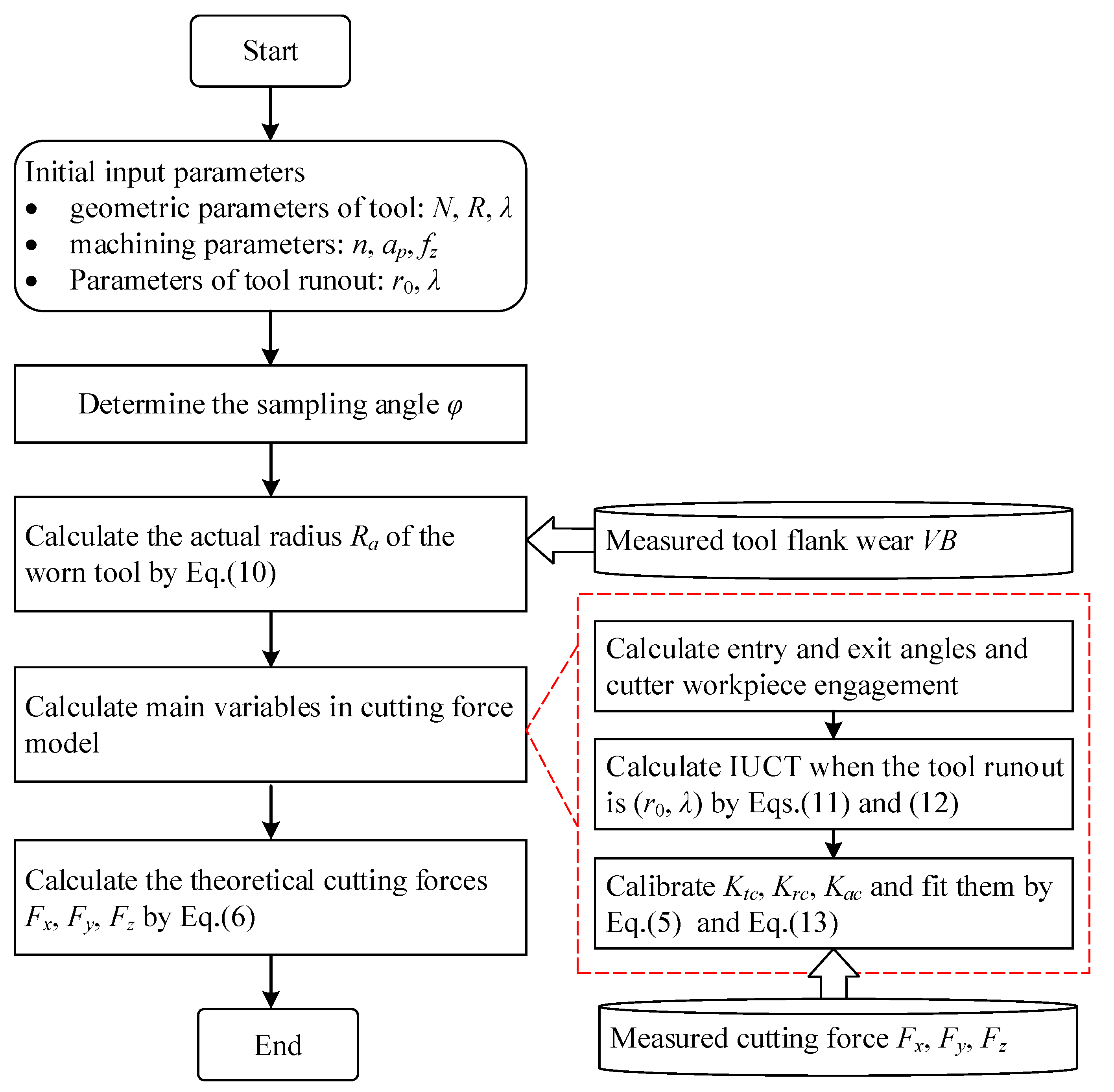
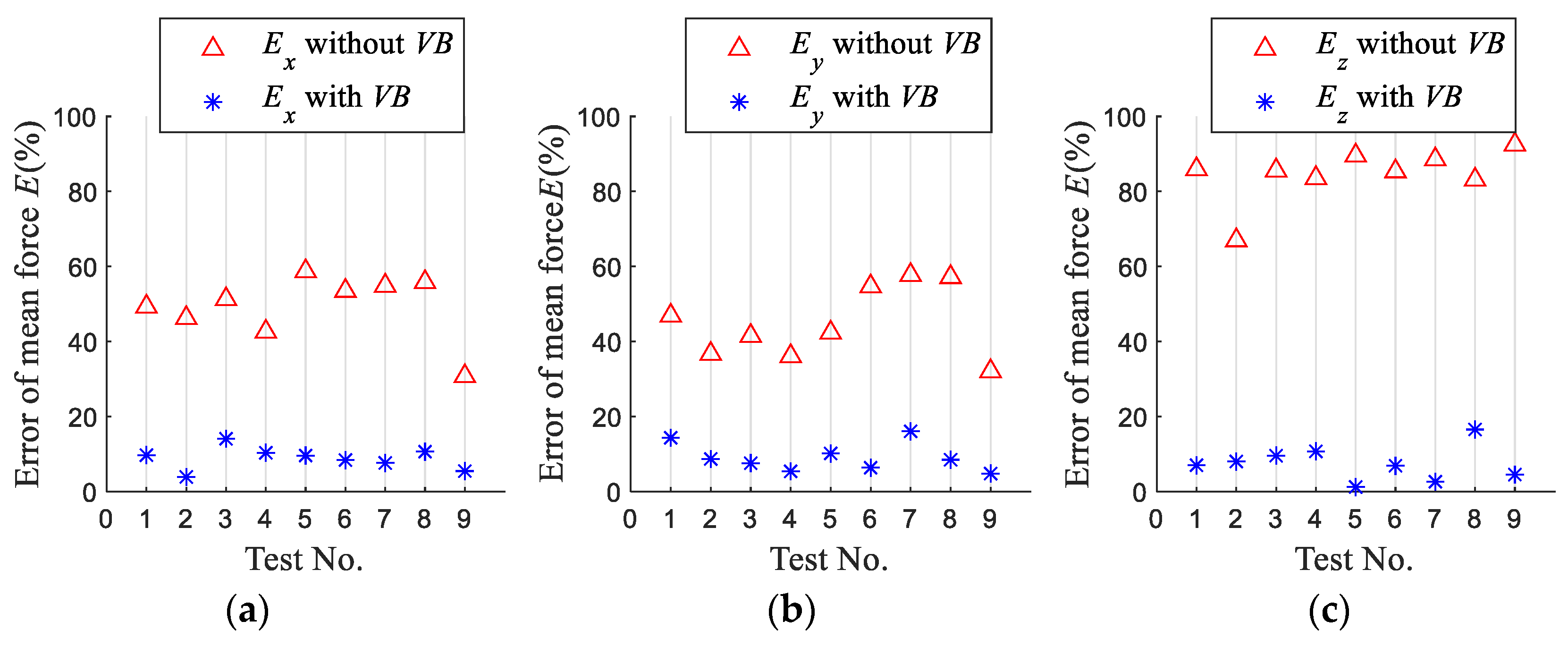
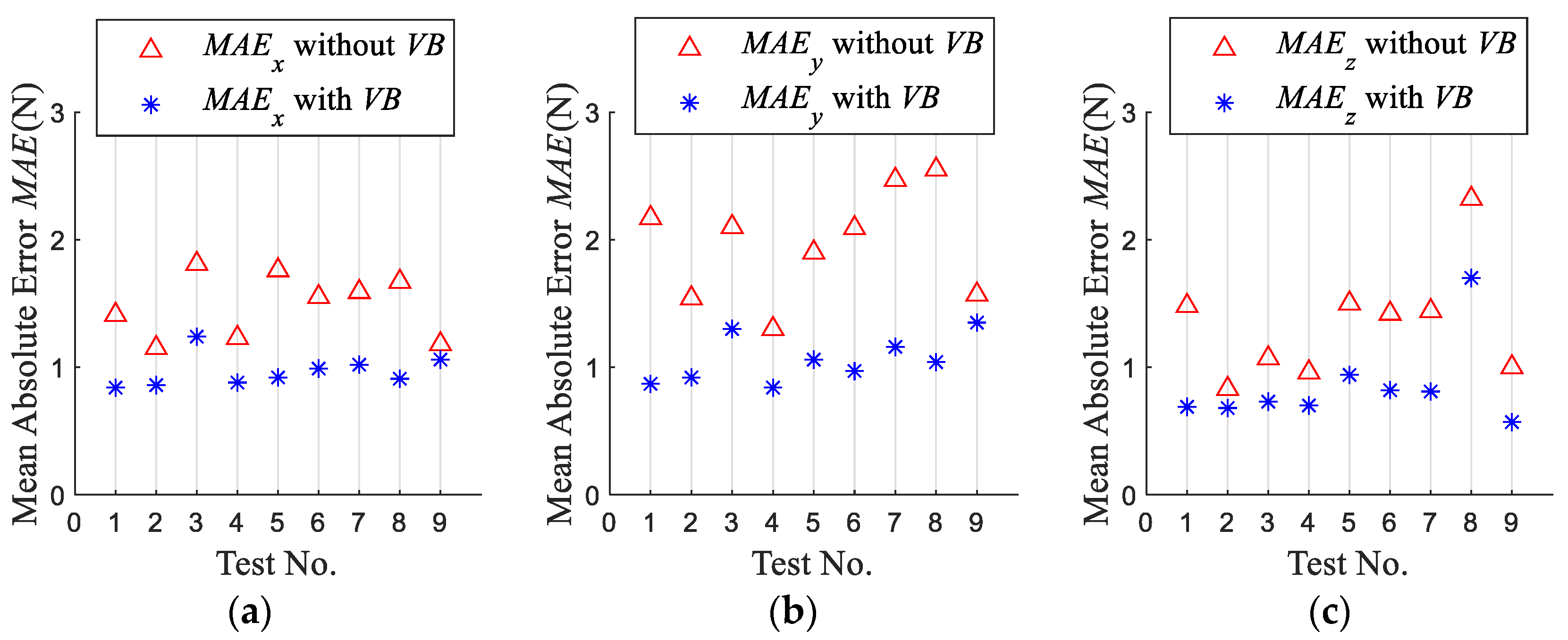
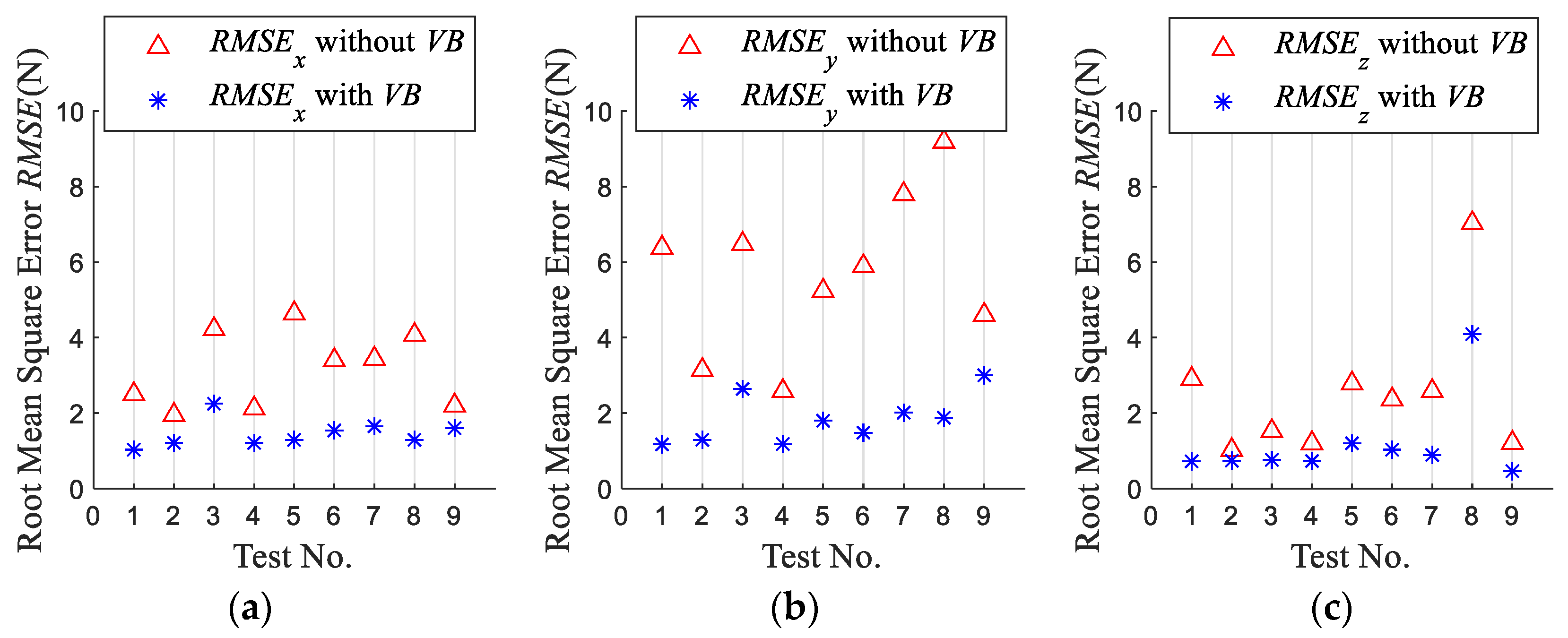


| Parameter | Value |
|---|---|
| Tool diameter d | 0.5 mm |
| Helix angle β | 30° |
| Rake angle γ | 10° |
| Clearance angle α | 5° |
| Tool edge radius r | 2 μm |
| Test No. | Spindle Speed n (r/min) | Axial Depth of Cut ap (μm) | Feed Per Tooth fz (μm/Tooth) |
|---|---|---|---|
| 1 | 18,000 | 60 | 2 |
| 2 | 18,000 | 80 | 4 |
| 3 | 18,000 | 100 | 6 |
| 4 | 24,000 | 80 | 6 |
| 5 | 30,000 | 60 | 6 |
| 6 | 24,000 | 60 | 4 |
| 7 | 24,000 | 100 | 2 |
| 8 | 30,000 | 80 | 2 |
| 9 | 30,000 | 100 | 4 |
| No. | r0 (μm) | λ (deg) | No. | r0 (μm) | λ (deg) |
|---|---|---|---|---|---|
| 1 | 1.531 | 75 | 6 | 1.617 | 70 |
| 2 | 1.423 | −85 | 7 | 0.22 | −55 |
| 3 | 0.761 | 76 | 8 | 0.671 | 90 |
| 4 | 1.805 | 61 | 9 | 0.336 | 85 |
| 5 | 0.378 | 31 |
| No. | R2x | R2y |
|---|---|---|
| 1 | 0.79 | 0.77 |
| 2 | 0.83 | 0.80 |
| 3 | 0.75 | 0.76 |
| 4 | 0.82 | 0.84 |
| 5 | 0.84 | 0.82 |
| 6 | 0.76 | 0.81 |
| 7 | 0.72 | 0.76 |
| 8 | 0.85 | 0.80 |
| 9 | 0.84 | 0.75 |
| No. | VB | No. | VB |
|---|---|---|---|
| 1 | 37.10 | 6 | 60.23 |
| 2 | 41.74 | 7 | 62.75 |
| 3 | 45.65 | 8 | 66.85 |
| 4 | 50.90 | 9 | 70.03 |
| 5 | 54.35 | 10 | 74.15 |
Publisher’s Note: MDPI stays neutral with regard to jurisdictional claims in published maps and institutional affiliations. |
© 2022 by the authors. Licensee MDPI, Basel, Switzerland. This article is an open access article distributed under the terms and conditions of the Creative Commons Attribution (CC BY) license (https://creativecommons.org/licenses/by/4.0/).
Share and Cite
Gao, S.; Duan, X.; Zhu, K.; Zhang, Y. Generic Cutting Force Modeling with Comprehensively Considering Tool Edge Radius, Tool Flank Wear and Tool Runout in Micro-End Milling. Micromachines 2022, 13, 1805. https://doi.org/10.3390/mi13111805
Gao S, Duan X, Zhu K, Zhang Y. Generic Cutting Force Modeling with Comprehensively Considering Tool Edge Radius, Tool Flank Wear and Tool Runout in Micro-End Milling. Micromachines. 2022; 13(11):1805. https://doi.org/10.3390/mi13111805
Chicago/Turabian StyleGao, Shuaishuai, Xianyin Duan, Kunpeng Zhu, and Yu Zhang. 2022. "Generic Cutting Force Modeling with Comprehensively Considering Tool Edge Radius, Tool Flank Wear and Tool Runout in Micro-End Milling" Micromachines 13, no. 11: 1805. https://doi.org/10.3390/mi13111805
APA StyleGao, S., Duan, X., Zhu, K., & Zhang, Y. (2022). Generic Cutting Force Modeling with Comprehensively Considering Tool Edge Radius, Tool Flank Wear and Tool Runout in Micro-End Milling. Micromachines, 13(11), 1805. https://doi.org/10.3390/mi13111805





